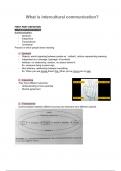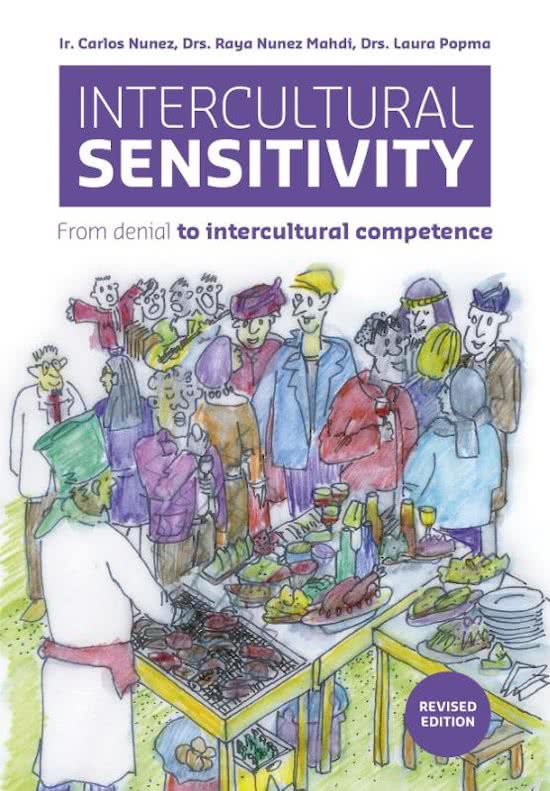What is intercultural communication?
FIRST PART DEFINITION
What is communication?
Communication:
- Symbolic
- Interpretive
- Transactional
- Contextual
Process in which people share meaning
1. Symbolic
- Objects, words (agreeing between people ex. ‘vuilbak’), actions representing meaning
- Interpreted as a message (‘package’ of symbols)
- Arbitrary no relationship, random, no reason behind it
Ex. someone doing a peace sign,
- Non-arbitrary: relationship between something
Ex. When you see smoke there's fire, When you’re crying your in pain
2. Interpretive
They have different outcomes:
- Understanding is here essential
- Shared agreement
3. Transactional
Communication between different sources and receivers from different cultures
, 4. Contextual
It can happen in different ways, impact on how you communicate depends on the setting
- Physical context
- Social context
- Interpersonal context
→ intercultural communication takes places in a intercultural context
5. Process
- Dynamic, developing, changing
- People create sharing meanings
SECOND PART OF THE DEFINITION
What is cultural?
→ A shared system of meanings
→ familiar way we think, feel and behave
Culture defined:
- Hofstede
Culture is collective programming of the human mind, which distinguishes the members of one
group or category of people from another
- Lustig & Koester
- Schein
a pattern of shared basic assumptions
that the group learned as it solved its problems of external adaptation and
internal integration, that has worked well enough to be considered valid and
therefore to be taught to new members as the correct way to perceive, think,
and feel in relation to those problems
, - trompenaars
Culture is the way in which a group of people solves problems
- Mijnd Huijser a group’s set of shared norms and
values expressed in the behaviour of the group’s members.
Analogie; The iceberg
- Only a small part of the iceberg visible, above the surface of the water: elements of
culture we can
easily notice: clothing, language, gestures, food, music, rituals,
- Much bigger invisible part of the iceberg below the surface: elements which aren’t
obvious: values, beliefs & attitudes
-
! It’s difficult to make sense of the visible aspects of a culture without understanding the
“invisible“
underlying elements from which they originate.
Cultural layers (onion) = analogie
1. Artefacts of culture: visible, first things you notice
→ outer layer, intercultural communication not going to be about artefacts
2. Norms and values: you have to spent some time in the culture to know them
→ second layer, take some time to notice, with necessary effort and observation they
can be learned.
Norms: written and unwritten standards of correct and desired behavior
Values: express what we think is good or right
3. Basic assumptions: learnt from when you were a child (people from the same culture
don’t even know them), we are unaware of their influence, used to form judgements and
for our perception of the world
→ deepest layer, in order to communicate creatively and more effectively with people
from other cultures, use cultural diversity at work as source of inspiration and growth,
and to achieve cultural synergy
Examples
1. Art, food, how people dress, physical gestures
2. Balance between work and home, corruption, social organization and class, family life,
Norm; how late can I be or how early do I need to be?
Value: is it good to stand up for an elderly person?
3. Humor, beliefs





